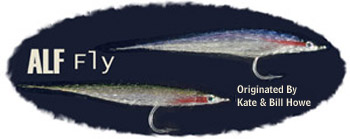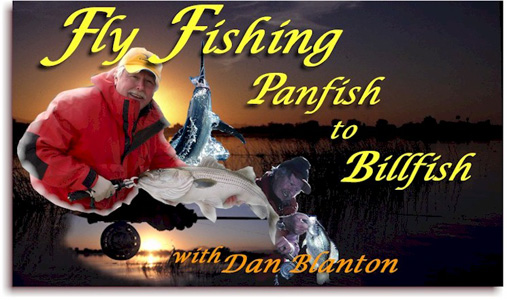I am pleased and honored to have Kate and Bill Howe’s Tarpon ALF featured as the first Hot Fly. Kate and Bill Howe are professional fly tiers who both have contributed much to our sport. The Tarpon ALF is just one of dozens of great ALF styles the Howes have created – all of which are deadly saltwater patterns, which will also work on a horde of freshwater critters. Many flats tarpon addicts get hung up on traditional flies, but those who know about the Tarpon ALF are scoring big time, when old favorites won’t open locked jaws. Give the Tarpon ALF a try, you won’t be sorry. Check out Kate & Bill’s website, too – it’s great!”TARPON ALF: (Blue Back & Green Back)
| Materials List |
| HOOKS: |
Gamakatsu SS15; 2/0, 3/0, 4/0 |
| THREAD: |
Danville’s Flat waxed nylon, white. |
| SUPER HAIR: |
Very fine .003 dia.. Colors for Tarpon ALFs; Blue Back: Polar Bear, lavender, Lt. Blue, Seafoam Green, Royal Blue and Black. Green Back: Polar Bear, Gray, Smoke, Olive, Dk. Green, Black. |
| FLASH: |
Flash and it’s application should relate directly to the type of bait fish being imitated and the water conditions being fished. In cases of cautious fish in extremely clear water flash should be used sparingly, if at all. Clouded or turbid water conditions call for more flash. Flash for Tarpon ALFs: Blue Back: Pearl Flashabou, Real Image’s 1/32″ Holographic mylar/silver. Krystal flash in Mixed Color. Green Back: Pearl Flashabou, Real Image’s 1/32″ Holographic mylar/gold. |
| THROAT: |
Red Fishair |
| EYES: |
Prismatic stick on, 2 1/2 mm |
| WEED GUARDS: |
Monel wire, coffee colored, sizes #4 or #6 (see directions below) |
| MARKING PEN: |
Black water proof for marking top of head or nose of fly to complete top line or dorsal definition. |
| GLUES AND CEMENTS: |
Jolli Glaze craft cement works well for us as it is generally thicker than most head cements and dries in a relatively short time to a hard clear finish. C.A. glues and accelerators are necessary for setting eyes prior to final glaze coat. |
TYING INSTRUCTIONS:
For Blue Back Tarpon Alf (substitute colors for Green Back)
| 1 |
Place hook securely in vise |
| 2 |
With “A” Monocord or flat waxed nylon, lay a thread base on the forward 1/3 of hook shank (from eye to just forward of hook point). Using only the forward 1/3 of the shank as the material tie in area helps to balance the fly so that it sinks nose down. |
| 3 |
Body construction: Cut 12 to 18 strands of Polar Bear Ultra Hair from top of hank and run up and down through fingers to make ends slightly uneven. Tie in on top of hook shank at hook point and secure with at about 8 wraps forward. This first section should extend back about 2.5″ from back of tie in. Take 4 strands of Pearl Flashabou, also with uneven ends, and tie in (a little longer than 1st section). When secure fold everything back and tie down. The piece you have just folded back will be quite a bit longer on top, take your scissors and trim at 3.5″ in a very uneven cut. A few pieces should be shorter than the bottom section while others should be as much as an inch longer as you taper towards the top. This technique allows you to form the proper taper for bait fish and should be continued throughout the pattern. Do not discard the piece that you have just cut off. |
| 4 |
Take 12 to 18 strands of Lt. Blue Super Hair and push up and down with fingers to make ends uneven. Secure on top of the Polar Bear at a little left of center of material and tie in. Add 2 strands of 1/32″ Holo Mylar 6″ long tied in at their center on top of nylon. Tie forward by dropping off of shoulder formed by previous material application. Fold back nylon and flash together, tie down and trim. Note: For a 3.5″ to 4.5″ fly You need to use at least 8 to 10 inches of nylon as these must be folded back into the pattern. This type of stacking and layering accomplishes two things: Folding makes a secure body as material will not pull out of head (remember nylon will not compress) and secondly, this method helps to keep the material ends uneven, which is most important for the proper bait fish silhouette and taper. |
| 5 & 6 |
Continue with next color, lavender with mixed color Krystal flash, following the same tying method described in steps #3 and #4, noting that section #5 is tied in a bit longer than the last. Section #6, Royal Blue, is then tied in just a little shorter to give the unique dorsal/ventral profile and taper. |
| 7 |
Top pattern with 4 strands of black Superhair tied in on top of last material. Tie forward to hook eye, fold back , tie down and secure. Trim. |
| 8 |
Rotate or invert hook in vise. Secure 12 to 18 strands of Polar Bear on underside of hook half way between point and eye. Tie forward to eye, fold back, secure and trim to proper belly taper.Return fly to upright position, 2″ section of bright red Fishair, 20 strands, to be tied in along side of head to form bleeding gills. Tie in along head on one side, then fold around nose (at hook eye) to the other side and tie down. These should not extend back past hook point. |
| 9 |
The final head finish or profile is achieved with thread build up and it must be wider top to bottom than from side to side. Use a black water proof marker to color top of head for definition. |
| 10 |
Eye should be set along each side of head, on the thread, Set eyes and coat head with C.A. glue , then spray very lightly with accelerator, let stand for one hour then coat with Jolli Glaze for finish. |
| Weed Guards |
Addition of double wire weed guard is best done at beginning of tying sequence. Cut 3″ to 4″ section of coffee colored Monel wire, fold in half, push ends down through top of hook eye until only 1/2″ protrudes from top. Tie that 1/2″ inch down hard against top of hook shank. The two ends of the guard will protrude from the underside of hook eye while you are building your pattern. After finishing your head off, fold wires back along bottom of head and leave loose. Finish guards by bending slightly backward to proper attitude then fold bottom 1/8″ to 1/4″ of each guard back on a 45 degree angle. The bent back ends should lay just under the hook point. Wire choices should be made on the basis of fly size and conditions it will be fished under. Monel wire sizes and corresponding diameters appropriate for Tarpon ALF’S are as follows; #4 through #6 with diameters of .013 to .014. |
|

